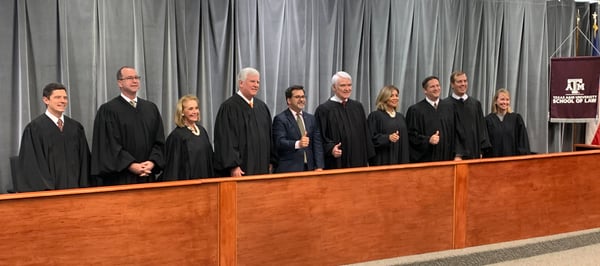Justices hear oral arguments on two cases before an audience of school faculty and students.
“May it please the Court,” began the oral argument of the first attorney presenting to the Supreme Court of Texas, convened in a packed auditorium at the Texas A&M University School of Law during the morning of October 10. At issue before the Court were two cases: the first - William Brewer v. Lennox Health Products (case 18-0426), involving a sanctioning of an attorney; and the second - In re: Murrin Brothers (case 18-0737), which covered how organizations are represented when their owners are in conflict.
First-year law students Ashana Stanley and Abigail Davis mentioned that students were given links to briefs on the cases to prepare for attending the session and completing assignments for separate courses. Professors “required us to take a quiz before the hearing to make sure we understood the overall, broad sense of what was being argued,” said Stanley.
While the legal questions involved merited in-depth discussions, those in the auditorium also noted the issues of polling/surveys, organizational development and governance and even linguistics.
Law school dean, Robert Ahdieh, welcomed the Court, the faculty, staff and students of the School, as well as interested visitors from the local community. “Our students will experience representatives of our legal profession at its very best – and see how our law is made,” he said.
Chief Justice Nathan Hecht expressed his appreciation to the Texas A&M School of Law for hosting the session, and he provided a short history of the Court’s 20-year program of holding sessions at venues away from Austin, that included a visit in 1999 to this particular campus, then being the Texas Wesleyan School of Law.
“Beginning in 1998, we have tried to sit outside Austin twice each year – once in the spring and again in the fall,” Chief Justice Hecht said. He listed the advantages of these visits to include offering the opportunity to the public throughout the state to “witness first hand the Texas justice system at work.” He added that, while the Court has live webcasts and has web archive access to video records of its proceedings, “actually being here presents an added dimension to the experience.”
During the oral arguments, as is typical, the prepared presentations of attorneys were quickly interrupted by the justices, cutting to the chase on specific points of law. The students were able to observe the legal give and take. The various attorneys “had their own style of arguing and were charismatic in their own way,” said Stanley.
Between cases, law school Professor Neil Sobol led a quick Q&A session with the law students in attendance. “The visit provided an excellent opportunity for our students to see the Texas Supreme Court and attorneys in a live setting. Additionally, the Justices not only graciously responded to questions after the morning hearings but also met with students at lunch and participated in our classes in the afternoon. Our law students were able to see how the concepts we discuss in class are used in the real world,” Sobol said.
The law students expressed their appreciation for this rare experience provided by the School of Law. Isabelle Chapman (first-year student) stated: “Having no attorneys in my family, I am so thrilled to be able to witness oral arguments in person. I feel very fortunate that the university has worked to get us this event.”
Attorney and past State Senator Ted Lyon, attending the oral arguments, commented that the visit by the Texas Supreme Court to the Texas A&M School of Law “is wonderful because it gives law students the opportunity to see some of the best attorneys anywhere argue an important aspect of the law. I wish they’d done that back when I was in law school.” He added, “I was very impressed with the School, its faculty and those I met. Everyone was very welcoming.”
Dean Ahdieh sees the visit as emblematic of the role of the School. "Texas A&M School of Law aims to serve as a 'meeting place' for the legal and business communities of Fort Worth, North Texas and Texas to come together and engage the most challenging social, political and economic issues of the day. The Court's visit offered an exciting opportunity for just such engagement,” he said.
“Pulling off a multi-day visit of the Court to the law school and broader community involved hard work and patience by so many of our faculty and staff - to all of whom I am immensely grateful," Ahdieh added.
“The Court's intent for an oral-argument setting outside Austin, as at Texas A&M School of Law, is primarily educational. And by that measure, our visit to Fort Worth was without doubt successful. But more than the opportunity to engage with students and faculty and the Tarrant County Bar Association, we were delighted with the hospitality shown us, truly a tribute to a city known for where the West begins,” said Chief Justice Hecht.
Law student Reese Griffin (first-year student) praised the School. “The opportunity to see the Texas Supreme Court makes me proud to attend Texas A&M School of Law,” he said.
Senator Lyon put it succinctly: “Texas A&M School of Law is hitting it out of the park!”
For the link to the Court recording of oral arguments on case 18-0426 click here http://www.texasbarcle.com/CLE/SCPlayer5.asp?sCaseNo=18-0426&bLive=&k=&T=
For the link to the Court recording of oral arguments on case 18-0737 click here http://www.texasbarcle.com/CLE/SCPlayer5.asp?sCaseNo=18-0737&bLive=&k=&T=